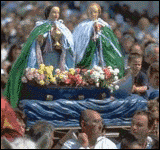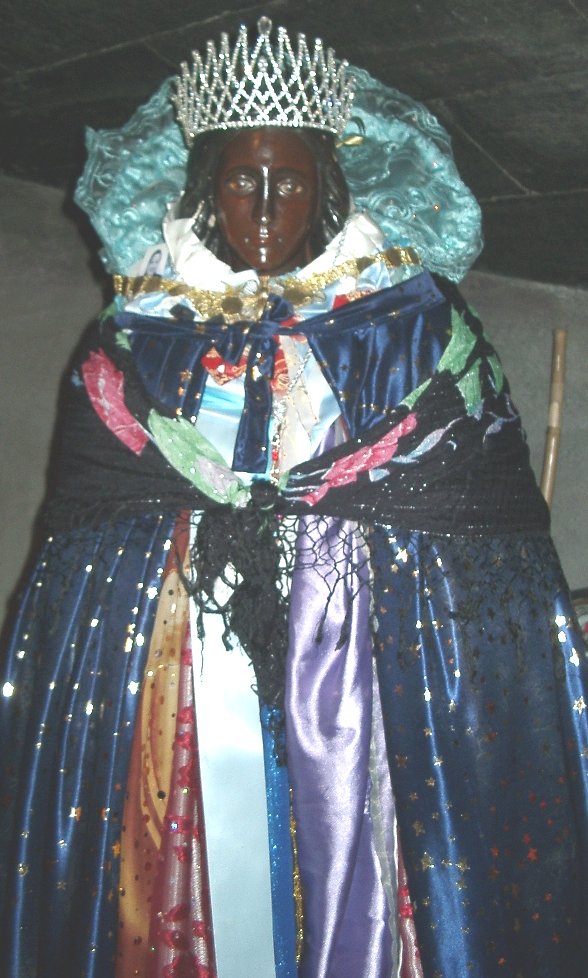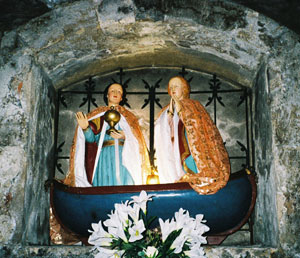Â
 Margaret Starbird wrote:
Margaret Starbird wrote:
May 23 is when the little town of Les Saintes-Maries-de-la-Mer begins to celebrate the festival of St. Sarah the Egyptian and the three Maries… (Mary Magdalene, Mary Jacobi and Mary Salomé) who allegedly arrived on the shore in “a boat with no oars” in c.AD 42…. apparently (according to French legend) bringing with them the Holy Grail and the “good news” of Christianity in their hearts (though it had yet to be written!)
The townspeople escort St. Sarah’s statue, dressed in seven layers of beautiful gowns created by tribes of Gypsy women, to the sea. Gypsy men on white horses carry the statue on a platform and stand in the waves while the crowd signs hymns and shouts “Vive Ste Sarah!”–
There are several suggestions as to why Sarah is black: she is “Egyptian” (i.e. born in Egypt), she is obscure (allegedly the maid-servant of the Maries, “just like Cinderella”) or, the one I consider most probably, she is a “hidden” offspring of the lineage of King David, whose heirs, “once white as milk, are now black as soot. They are not recognized in the streets” (Lamentations 4:7-8)… The bearers of that royal line are now political refugees in a foreign land…hoping to evade notice of the Romans who might seek to destroy them (as they did other relatives of Jesus in the first century). There is only one child on the boat in the French legends–and her name “Sarah” means “princess” in Hebrew.
Who do we say she is?
peace and light,
Margaret
* * * * * * * * * * * * * * * * * *
Professor Mary Ann Beavis posted in with this intriguing connection:
I say that she's Kali-Sarah, the christianized goddess of the Romany, originally from India (hence, the veneration of the dark goddess Kali).
Mary Ann
* * * * * * * * * * * * *
I then asked Margaret what legend is it where we see the little princess Sarah in the boat with no oars.
Scroll down below St Sarah’s picture and read Margaret’s answer…

* * * * * * * * * * * * * * * * * *
Hi, Katia,
Today, May 24, is Saint Sarah’s actual feast day.
The legends about St. Sarah stem from an long-standing oral tradition and have several variations. They were not available in any extant written form until after the Inquisition was securely entrenched in Southern France, so our chances of hearing the complete and unabridged story of St. Sarah are slim and none. Jacobus Voragine’s Golden Legend names “Marcelle” as the servant of Martha (Mary Magdalene’s sister), who travelled with the other refugees from Jerusalem in the boat with no oars. But at St. Maries de la Mer, this “serving girl” is called “St. Sarah”–based on legends apparently indigenous to the area. One late version of the story says that Sarah the Egyptian (also called Sarah the Black) was an gypsy queen who welcomed the refugees to France when they arrived, but since the gypsies themselves didn’t show up in Europe until the 14th century, that account can’t be the true version.
Wikipedia has a piece on St. Sarah here.
And here is the Golden Legend section on the topic.
and this blog entry called Celebrating with Saint Sarah has interesting info:
 Here’s my story (longer version is published in my “Goddess in the Gospels.” While my husband was the district engineer in Nashville, TN, we were invited to go out dinner with a group French mayors and their wives who were visiting. At the time, I was totally immersed in “Grail” research and found myself sitting next to a French woman who was the wife of one of the deputy mayors. I asked her about the early Christians on the shores of France and she lit up like a torch…. she had been to all the shrines of the Black Madonnas and to St. Maries de la Mer and knew all the “lore.” She told me about St. Sarah, and when I asked who she was, Madame Capolla told me that Sarah was “the little girl on the boat” with Mary Magdalene and Martha and Lazarus and the others who came from Jerusalem. When I got home I looked up “Sarah” in my concordance and discovered that it means “Princess.”
Here’s my story (longer version is published in my “Goddess in the Gospels.” While my husband was the district engineer in Nashville, TN, we were invited to go out dinner with a group French mayors and their wives who were visiting. At the time, I was totally immersed in “Grail” research and found myself sitting next to a French woman who was the wife of one of the deputy mayors. I asked her about the early Christians on the shores of France and she lit up like a torch…. she had been to all the shrines of the Black Madonnas and to St. Maries de la Mer and knew all the “lore.” She told me about St. Sarah, and when I asked who she was, Madame Capolla told me that Sarah was “the little girl on the boat” with Mary Magdalene and Martha and Lazarus and the others who came from Jerusalem. When I got home I looked up “Sarah” in my concordance and discovered that it means “Princess.”
Madame C. later mailed me several pamphlets and booklets from the shrines and Stes Maries, including pictures of St. Sarah dressed in her beautiful organdy and brocade dresses (piled on top of one another). The parallels with Cinderella (another princess from a far away land who is alleged to be the servant of her relatives) are obvious, along with the quote I provided from Lamentations about the faces of the heirs of King David, “now black as soot.”—
I personally think this story was so dangerous in the Middle Ages that it was couched in symbolism and told as a myth or legend. The “fossil” left for evidence is the title “Sarah” (princess) given to the child/servant (whom Voragine names “Marcelle”–but then, Voragine was a Roman Catholic bishop, so perhaps he was providing deliberate misinformation in his Magdalene story (most of which reads like pure fiction anyhow!).
peace and light,
Margaret
“The Woman with the Alabaster Jar”
www.margaretstarbird.net
Mary posted:
>….My research has told me that The Mothers of Arles Festival is held on the 24th ( from Juno Covella and The White Goddess) or this
> festival is celebrated from May 24-28th (The Grandmother of Time, Z. Budapest). I am curious to know how the 23rd of May fits in?
> Did you get this date from another text or have you visited Arles to see it taking place today?
________________
I have been to Les Saintes-Maries-da-la-Mer for the festival of Saint
Sarah and the “Maries” —which begins on the evening of the 23rd of
May with music and street dancing. Gypsies and tourists flock to the
town to celebrate the “vigil” of the festival. The 24th (today) is the
actual feast of St. Sarah, whose statue is kept in the crypt of the
basilica. A local bishop says high Mass in the basilica (“Our Lady of
the Sea”) in her honor, and then Sarah’s statue, bedecked in fabulous
finery, is taken from the church and escorted to the sea. Tomorrow (25
May) is the feast of the “Maries.” Their replica of two women with
covered chalices standing in a blue boat is lowered from it’s position
above the altar and is escorted to the sea, similar to the Sarah
parade and ceremony on the 24th. I’m not sure how this folk festival
ties in with other ancient “Goddess” celebrations, but I wouldn’t be
surprised if it did! Syncretism of ancient goddesses of love and
fertility abounds in the region: Isis, Juno, Cybele, Venus, Diana et alia.
peace and well-being,
Margaret